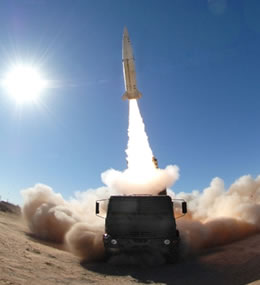

Bahrain and Dubai are expecting to get more MGM-164 Army Tactical Missile System (ATACMS) manufactured by Lockheed Martin. Last week the Defense Security Cooperation Agency notified the U.S. Congress about the planned sale of 130 ATACMS missiles carrying Unitary Warheads T2K (MGM-164), equipping the two gulf states with medium range ballistic missile capability for the first time. The new warhead also offers improved penetration and optimized fragmentation coverage, thus reducing collateral damage.
According to the agency, the United Arab Emirates’ Army will get 100 ATACMS missiles while Bahrain buy additional 30. The recent announcement includes only missiles, but no launchers, as both countries already have the High Mobility Artillery Rocket Systems (HIMARS) in service.
UAE will also order 60 ‘Low Cost Reduced Range Practice Rockets’ (LCRRPR) to support the training and demonstration of the new weapon’s capabilities. UAE is investing $140 million while Bahrain’s acquisition is expected to amount to $70 million, reflecting the proportionally higher cost of setup and support systems.
The UAE has initially requested acquiring tactical missile systems from the U.S. – in 2006, as the U.S. agency announced an intended sale of 20 HIMARS vehicles, 100 ATACMS missiles and 130 Guided Multiple Launch Rocket Systems (GMLRS) carrying Dual Purpose Improved Conventional Munitions (DPICM) and an equal number of ATACMS and GMLRS carrying unitary warheads. The total value of the 2006 package was $752 million. While the deal was never publicized, the U.S. is known to operate a training facility in the country to establish a the cadre for the HIMARS school training local crews in the operation of GMLRS and ATACMS. Bahrain is also operating HIMARS and ATACMS missiles for several years. The new acquisition will be able to replace those missiles carrying DPICM – as they are phase out of service, in compliance with the new international treaty banning the export and use of cluster munitions, which came into effect in 2009.

Four years later, on December 20, 2010 the Pentagon awarded Lockheed Martin an order worth over $900 million, for the delivery of 226 ‘tactical missiles’ and 24 launcher modification kits, plus logistical support under Foreign Military Sale (FMS) to the UAE and Taiwan. It is yet unclear whether this order traces back to the original sale announced in 2006, since the first missile regiment has already been established by the Emirate, trained by U.S. instructors. As for Taiwan they currently don’t have ATACMS, nor do they posses MLRS, GMLRS or HIMARS so the actual identity of these missiles is still a mystery…
So the big question is – which tactical Missiles Lockheed Martin will be delivering to Taiwan, or – how the ATACMS order inflated from $140 to over $700 million?.
The new sales can also be considered part of the gulf states’ force modernization, expanding their existing architecture to counter major regional threats – namely an attack by Iranian air power, ballistic missiles or naval forces. While Iran could potentially devastate the gulf states’ air forces, the presence of highly mobile medium range missiles could provide these small states a ‘Second Strike’ potential, presenting a deterrent effect against an Iranian strike. The range of these missiles put strategic Iranian shoreline facilities at risk, including the port of Bandar Abas and the nuclear sites at Bushehr.
















